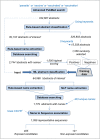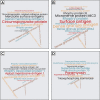Compilation of parasitic immunogenic proteins from 30 years of published research using machine learning and natural language processing
- PMID: 35725870
- PMCID: PMC9208253
- DOI: 10.1038/s41598-022-13790-1
Compilation of parasitic immunogenic proteins from 30 years of published research using machine learning and natural language processing
Abstract
The World Health Organisation reported in 2020 that six of the top 10 sources of death in low-income countries are parasites. Parasites are microorganisms in a relationship with a larger organism, the host. They acquire all benefits at the host's expense. A disease develops if the parasitic infection disrupts normal functioning of the host. This disruption can range from mild to severe, including death. Humans and livestock continue to be challenged by established and emerging infectious disease threats. Vaccination is the most efficient tool for preventing current and future threats. Immunogenic proteins sourced from the disease-causing parasite are worthwhile vaccine components (subunits) due to reliable safety and manufacturing capacity. Publications with 'subunit vaccine' in their title have accumulated to thousands over the last three decades. However, there are possibly thousands more reporting immunogenicity results without mentioning 'subunit' and/or 'vaccine'. The exact number is unclear given the non-standardised keywords in publications. The study aim is to identify parasite proteins that induce a protective response in an animal model as reported in the scientific literature within the last 30 years using machine learning and natural language processing. Source code to fulfil this aim and the vaccine candidate list obtained is made available.
© 2022. The Author(s).
Conflict of interest statement
The authors declare no competing interests.
Figures






Similar articles
-
Development and Evaluation of a Cryopreserved Whole-Parasite Vaccine in a Rodent Model of Blood-Stage Malaria.mBio. 2021 Oct 26;12(5):e0265721. doi: 10.1128/mBio.02657-21. Epub 2021 Oct 19. mBio. 2021. PMID: 34663097 Free PMC article.
-
Molecular vaccines against animal parasites.Vaccine. 1989 Aug;7(4):291-9. doi: 10.1016/0264-410x(89)90188-6. Vaccine. 1989. PMID: 2683456 Review.
-
Key Limitations and New Insights Into the Toxoplasma gondii Parasite Stage Switching for Future Vaccine Development in Human, Livestock, and Cats.Front Cell Infect Microbiol. 2020 Nov 25;10:607198. doi: 10.3389/fcimb.2020.607198. eCollection 2020. Front Cell Infect Microbiol. 2020. PMID: 33324583 Free PMC article. Review.
-
[The new generations of vaccines against parasites].Wiad Parazytol. 2000;46(1):21-7. Wiad Parazytol. 2000. PMID: 16886350 Review. Polish.
-
Vaccination against animal parasites.Vet Parasitol. 1994 Aug;54(1-3):177-204. doi: 10.1016/0304-4017(94)90090-6. Vet Parasitol. 1994. PMID: 7846850 Review.
Cited by
-
Antigen discovery by bioinformatics analysis and peptide microarray for the diagnosis of cystic echinococcosis.PLoS Negl Trop Dis. 2023 Apr 12;17(4):e0011210. doi: 10.1371/journal.pntd.0011210. eCollection 2023 Apr. PLoS Negl Trop Dis. 2023. PMID: 37043489 Free PMC article.
References
-
- Price PW. Evolutionary biology of parasites. Monogr. Popul. Biol. 1980;15:1–237. - PubMed
Publication types
MeSH terms
Substances
LinkOut - more resources
Full Text Sources
Medical

